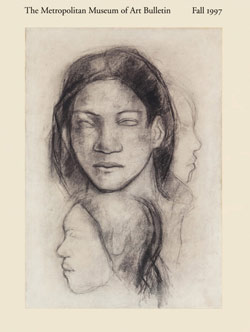Untitled
Francesca Woodman American
Not on view
Photography's role in the avant-garde expanded dramatically in the 1970s, with artists using the camera to document a wide array of performance-based work, in which the body was both subject and medium. This radical new art had an added force in the hands of women artists who, in reclaiming their bodies and, by extension, their identities as subject matter, revealed the essential link between the personal and the political. As a young student at the Rhode Island School of Design, Woodman also used herself as subject, merged with architectural elements in claustrophobic interiors or transfigured into natural forms such as trees. In these less explicitly political, more lyrical images, the artist, who took her own life at the age of twenty-three, charts almost diaristically the states of her soul and her quest for identity.
This late work is a unique, nearly lifesize print on architect's paper and was intended as a study for Woodman's "Temple Project," an unfinished installation planned for the Alternative Museum, New York City. Here, the artist poses as a monumental headless caryatid; other studies show this motif repeated as a frieze. Resurrected from stone like Sylvia Plath's "Lady Lazarus," the colossal figure oscillates between the flesh and its sculpted surrogate. Woodman's fierce repossession of the female form from the arena of male ingenuity and desire is one of the most potent statements of her abbreviated career.
Due to rights restrictions, this image cannot be enlarged, viewed at full screen, or downloaded.
This artwork is meant to be viewed from right to left. Scroll left to view more.




